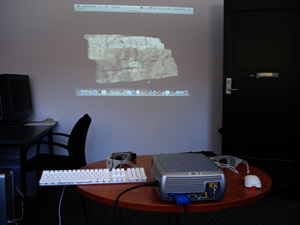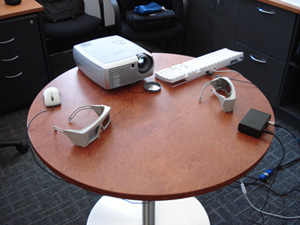DepthQ projector (a brief) evaluation
Written by Paul Bourke
January 2008
The following is a very brief test/evaluation of the DepthQ projector
as a means of presenting stereoscopic content. The DepthQ projector
been around for a few years and is interesting in so far as it is
a relatively low cost projector (DLP) that can support 120Hz frame
sequential stereoscopic projection. It has occupied a unique position
in the market since its release because the next alternative/competitor
is at least an order of magnitude more expensive. The main market for
this projector is as a portable projection system that, unlike
passive
polaroid based stereoscopic projection, does not require a special screen
surface nor does it require a tedious and often time consuming projector
alignment/calibration.
The main reason for this test was to verify that it functioned with
Mac OS-X and Linux, this was verified. In both cases, the Linux box and
Mac Pro, an nVidia fx4500 was used. In terms of image quality, the projector
performed as expected given that it is only 800x600 pixels. At 1600 ansi
lumens peak it isn't bright but about average given its vintage and
price range.
Notes
The Mac OS-X drivers for the fx4500 do not seem to leave the emitter
on. This means that while one can run a stereoscopic application either
full screen or in a window, when no stereoscopic application is
running the projector looses the sync signal, the result seems to be
60Hz flicker. This is rather disappointing since the ability to jump
to/from the OS to stereoscopic enabled apps is one of the benefits
of active stereo over many other technologies.
The particular Linux drivers used seem to leave the
emitter running all the time, an engineer writing the Apple drivers
probably thought they were saving the emitters life (bad choice).
A box large enough and with enough power for a fx4500
(probably overkill for the likely applications) hardly results
in a "portable system", especially when it comes to a heavy Mac Pro. Of course
for MSWindows and Linux there are smaller lighter boxes into which lower end,
cheaper stereoscopic capable graphics cards can be installed.
The NuVision 60GX glasses were used, they (in the authors opinion)
are by far the most cost effective LCD shutter glasses with a wide field of view.
There are at least two IR emitters that can be used with the NuVision
wireless glasses. The one above is
intended to cover a wide area, there are also the smaller original
emitters from NuVision that can be daisy chained to cover a wider area.
|

